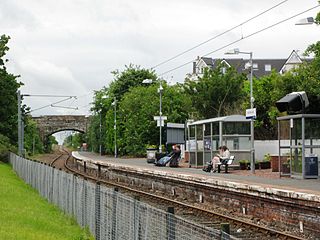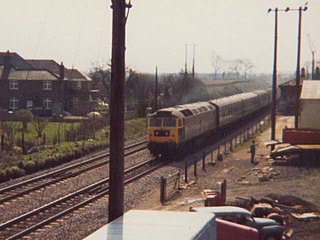
Feniton railway station serves the village of Feniton in Devon, England. It was opened by the London and South Western Railway (LSWR) in 1860 but is now operated by South Western Railway which provides services on the West of England Main Line. It is 159 miles 24 chains (256.4 km) down the line from London Waterloo.

Exmouth railway station serves the town of Exmouth in Devon, England and is 11.25 miles (18 km) south east of Exeter St Davids. The station is the terminus of the Avocet Line from Exeter St Davids. The station is managed by Great Western Railway, who operate all trains serving it.

Salisbury railway station serves the city of Salisbury in Wiltshire, England. It is 83 miles 43 chains (134.4 km) from London Waterloo on the West of England line to Exeter St Davids. This is crossed by the Wessex Main Line from Bristol Temple Meads to Southampton Central. The station is operated and served by South Western Railway (SWR), and is also served by Great Western Railway (GWR).

Longniddry railway station is located at the southeast corner of the village of Longniddry, East Lothian, Scotland. The station is on the East Coast Main Line, 13+1⁄4 miles (21.3 km) east of Edinburgh Waverley, and is served by stopping passenger trains on the North Berwick Line.

Par railway station serves the villages of Par, Tywardreath and St Blazey, Cornwall, England. The station is 282 miles (454 km) from London Paddington via Bristol Temple Meads. It is the junction for the Atlantic Coast Line to Newquay.

Bridgwater railway station serves Bridgwater in Somerset, England. It is on the Bristol to Taunton Line and is operated by Great Western Railway. It is 151 miles 47 chains from the zero point at London Paddington via Box.

North Berwick railway station is a railway station serving the seaside town of North Berwick in East Lothian, Scotland. It is the terminus of the Edinburgh to North Berwick Line, 22+1⁄4 miles (35.8 km) east of Edinburgh Waverley.

Barnoldswick railway station was the only railway station on the Midland Railway's 1-mile-64-chain (2.9 km) long Barnoldswick Branch in the West Riding of Yorkshire in England. It served the market town of Barnoldswick, which was in West Riding of Yorkshire at the time. The line left the Leeds and Bradford Extension Railway at Barnoldswick Junction 55 chains from Earby railway station. The line through the junction was on a 20-chain radius after which it converged to a single track and ran in a straight but undulating line to Barnoldswick. The passenger train that ran back and forth between Barnoldswick and Earby was known locally as the 'Barlick Spud' or 'Spudroaster'. The real reason for the name is lost in time, but the two versions that were commonly recited are that the original branch locomotive was so small it looked like a portable potato roaster used by a local vendor or that the journey time was the same as that taken to roast a potato in the locomotive's firebox.

The Holmfirth branch line is a disused railway line that ran for 2 miles (3.2 km) from Brockholes to Holmfirth, in West Yorkshire, England. The line was built as double track as there were plans to extend the line up the Holme Valley.

There are eleven disused railway stations between Exeter St Davids and Plymouth Millbay, Devon, England. At eight of these there are visible remains. Of the eleven stations, South Brent and Plympton are subject of campaigns for reopening while Ivybridge station was replaced by another station on a different site.

Hammersmith & Chiswick was a railway terminus in west London that was opened in 1858 by the North & South Western Junction Railway and closed in 1917, during the First World War.
Kingthorpe railway station was a railway station that served the village of Kingthorpe, Lincolnshire, England between 1874 and 1956, on the Louth to Bardney line.

Wragby railway station was a railway station that served the town of Wragby, Lincolnshire, England between 1874 and 1960, on the Louth to Bardney line.

East Barkwith railway station was a railway station that served the village of East Barkwith, Lincolnshire, England between 1874 and 1958, on the Louth to Bardney line.

New Romney and Littlestone-on-Sea was a railway station which lay in between the villages of New Romney and Littlestone-on-Sea in Kent, England. The station opened in 1884 and closed in 1967.

Kidlington railway station opened in 1852 on the Oxford and Rugby Railway to serve the adjacent Oxfordshire village of Kidlington, and act as a railhead for the town of Woodstock, 2.5 miles (4.0 km) away. It became a junction station in 1890 upon the opening of the Blenheim and Woodstock Branch Line, and served the area for over 100 years before falling victim to the programme of closures initiated by the Beeching Report in 1964. Following many proposals for its reopening, a new station to serve Kidlington opened in October 2015 at Oxford Parkway on the Oxford to Bicester Line.
Lydbrook Junction railway station is a disused railway station in England opened by the Ross and Monmouth Railway in 1873, it remained open for 91 years until 1964 when the line finally closed to freight, though passenger services ceased in 1959. The station was constructed in the hamlet of Stowfield approximately half a mile from Lydbrook and its viaduct on the Severn and Wye Railway. It was located approximately 4 miles and 34 chains along the railway from Ross-on-Wye station. In 1874 the Severn and Wye Railway opened a branch from Serridge Junction and Cinderford, passenger services commenced in 1875. All passenger trains along the S&W branch were withdrawn from 1929.
The Sidmouth Railway was a railway branch line that ran from a junction at Feniton to Sidmouth, connecting the resort to the main line network.
The Yeovil–Taunton line was a railway line in England, built by the Bristol and Exeter Railway (B&ER) to connect its main line with the market town of Yeovil in Somerset. It opened in 1853 using the broad gauge of 7 ft 1⁄4 in and was the first railway to serve Yeovil. It ran from a junction at Durston although in later years passenger trains on the line ran through to and from Taunton where better main and branch line connections could be made.

Borwick railway station formerly served the village of Borwick in Lancashire, England. It was located on the Furness and Midland Joint Railway line between Carnforth and Wennington, 3 miles (5 km) east of Carnforth Joint station.
















